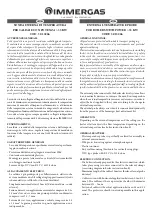
Features and Specifications
HeatNet Control V3
Page 7
is entered. Once in the Heat Band, modulation is used to
maintain setpoint. Boilers are shut down only when the top
of the Heat Band is breached. Timers are also used to
prevent short cycling.
While staging the boilers on, a modulation clamp is used to
hold the boilers at a lower fire rate until the last boiler is
fired. Once the last boiler fires the modulation clamp is
removed, and all boilers are allowed to fire above this
clamped percentage up to 100%. This “boiler efficiency”
clamp is defaulted to 70% and thus limits all boilers
individual outputs to 70% until the last boiler fires. All
running boilers modulate up and down together, always at
the same modulation rate. As a rule, this percentage should
be no lower than twice the minimum turndown to minimize
short cycling.
When additional boilers are needed to achieve setpoint in
the system, the Master boiler employs an ADAPTIVE
MODULATION algorithm to prevent over firing of the
system. The Master communicates over the H-Net to view
the exact status of each Member boiler. When a new boiler
is added, the Master boiler adjusts the system modulation
rate lower to compensate for the BTUs that will be
introduced by the newly added boiler. This adjustment
occurs when the newly added Member boiler enters its ON
CALL state (default setting). This can be changed to
IGNITION when the new boiler is called using the menu:
ADAPTIVE MOD: DROP DOWN.
Once the Main Valve
(on the newly added boiler) is opened, and the
DELAY
RELEASE
timer equals zero, the PID algorithm is allowed
to control the system modulation.
Setting
the DELAY
RELEASE timer will allow some “soak” time of the newly
added boiler before releasing modulation control to the PID.
The ADAPTIVE MOD menus are disabled
on a Member boiler, but are still visible.
Member
If a “SYS/DHW HEADER” sensor is
not
connected to J10,
a boiler always defaults to the role of Member.
The Member boiler can operate as part of a multi-boiler
system or as a stand-alone unit.
In a multi-boiler system, the Member typically receives its
command signals from a designated Master-boiler. It is also
capable of receiving inputs from an external control system.
The boiler responds to these signals, to start/stop the burner,
and/or to modulate the firing rate. The outlet water
temperature is also monitored. If the outlet temperature
approaches the operating limit temperature setpoint
(adjustable), the boilers’ firing rate is limited, and its
modulation value is reduced to minimize short cycling. If
the operating limit is exceeded, or if an interlock trips, the
boiler is shut down. When connected with a network cable,
in a Master/Member role, the Members' status is
interrogated by the Master boiler.
In a stand-alone installation the Member typically receives
its command signals internally and operates based upon the
outlet water temperature input and the established settings in
the menu (Local Set-point) to start/stop the burner, and/or to
modulate the firing rate. If the operating limit is exceeded,
or if an interlock trips, the boiler is shut down. As in a
multi-boiler system, a stand-alone Member boiler is also
capable of receiving inputs from an external control system.
When using the H-Net network cable in a Master/Member
system, the system setpoint is sent from the Master as a
digital signal, along with the modulation value to control
firing rate. It also receives its command to start or stop over
the H-Net cable. Also, the SYSTEM CLOCK only needs to
be set on the MASTER. The Master will then set the time
on all member boilers.
If not using the H-Net protocol (cable), an external control
can send a 4-20mA signal along with a 4-20mA enable
signal to control the firing rate or setpoint. The boiler may
also be treated as a 2-stage boiler or an ON-OFF boiler
using the dedicated T-inputs.








































